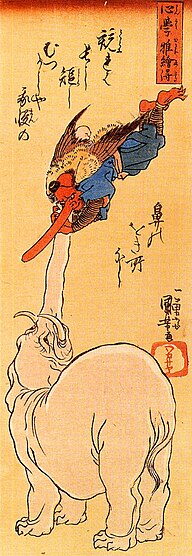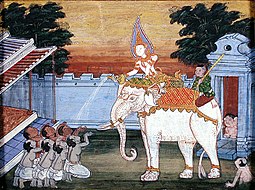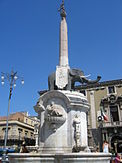ਹਾਥੀਆਂ ਦੇ ਸੱਭਿਆਚਾਰਕ ਚਿੱਤਰਣ
ਹਾਥੀਆਂ ਨੂੰ ਮਿਥਿਹਾਸ, ਪ੍ਰਤੀਕਵਾਦ, ਅਤੇ ਪ੍ਰਸਿੱਧ ਸੱਭਿਆਚਾਰ ਵਿੱਚ ਦਰਸਾਇਆ ਗਿਆ ਹੈ। ਉਹ ਦੋਵੇਂ ਧਰਮ ਵਿੱਚ ਸਤਿਕਾਰੇ ਜਾਂਦੇ ਹਨ, ਅਤੇ ਯੁੱਧ ਵਿੱਚ ਆਪਣੀ ਤਾਕਤ ਲਈ ਸਤਿਕਾਰੇ ਜਾਂਦੇ ਹਨ। ਉਹਨਾਂ ਦੇ ਨਕਾਰਾਤਮਕ ਅਰਥ ਵੀ ਹਨ, ਜਿਵੇਂ ਕਿ ਇੱਕ ਬੇਲੋੜੇ ਬੋਝ ਲਈ ਪ੍ਰਤੀਕ ਹੋਣਾ। ਪੱਥਰ ਯੁੱਗ ਤੋਂ ਲੈ ਕੇ, ਜਦੋਂ ਹਾਥੀਆਂ ਨੂੰ ਪ੍ਰਾਚੀਨ ਪੈਟਰੋਗਲਾਈਫਸ, ਅਤੇ ਗੁਫਾ ਕਲਾ ਦੁਆਰਾ ਦਰਸਾਇਆ ਗਿਆ ਸੀ, ਉਹਨਾਂ ਨੂੰ ਚਿੱਤਰਾਂ, ਮੂਰਤੀਆਂ, ਸੰਗੀਤ, ਫਿਲਮਾਂ, ਅਤੇ ਇੱਥੋਂ ਤੱਕ ਕਿ ਆਰਕੀਟੈਕਚਰ ਸਮੇਤ ਕਲਾ ਦੇ ਵੱਖ-ਵੱਖ ਰੂਪਾਂ ਵਿੱਚ ਦਰਸਾਇਆ ਗਿਆ ਹੈ।

ਧਰਮ, ਮਿਥਿਹਾਸ ਅਤੇ ਦਰਸ਼ਨ
[ਸੋਧੋ]

ਏਸ਼ੀਆਈ ਹਾਥੀ ਵੱਖ-ਵੱਖ ਧਾਰਮਿਕ ਪਰੰਪਰਾਵਾਂ, ਅਤੇ ਮਿਥਿਹਾਸ ਵਿੱਚ ਪ੍ਰਗਟ ਹੁੰਦਾ ਹੈ। ਉਹਨਾਂ ਨੂੰ ਸਕਾਰਾਤਮਕ ਢੰਗ ਨਾਲ ਪੇਸ਼ ਕੀਤਾ ਜਾਂਦਾ ਹੈ, ਅਤੇ ਕਈ ਵਾਰੀ ਉਹਨਾਂ ਨੂੰ ਦੇਵਤਿਆਂ ਵਜੋਂ ਸਤਿਕਾਰਿਆ ਜਾਂਦਾ ਹੈ, ਅਕਸਰ ਤਾਕਤ, ਅਤੇ ਬੁੱਧੀ ਦਾ ਪ੍ਰਤੀਕ ਹੁੰਦਾ ਹੈ। ਇਸੇ ਤਰ੍ਹਾਂ, ਅਫ਼ਰੀਕੀ ਹਾਥੀ ਨੂੰ ਇੱਕ ਬੁੱਧੀਮਾਨ ਮੁਖੀ ਵਜੋਂ ਦੇਖਿਆ ਜਾਂਦਾ ਹੈ, ਜੋ ਅਫ਼ਰੀਕੀ ਕਥਾਵਾਂ ਵਿੱਚ ਨਿਰਪੱਖਤਾ ਨਾਲ ਜੰਗਲੀ ਜੀਵਾਂ ਵਿਚਕਾਰ ਝਗੜਿਆਂ ਦਾ ਨਿਪਟਾਰਾ ਕਰਦਾ ਹੈ, [2] ਅਤੇ ਅਸ਼ਾਂਤੀ ਪਰੰਪਰਾ ਮੰਨਦੀ ਹੈ ਕਿ ਉਹ ਪੁਰਾਣੇ ਸਮੇਂ ਤੋਂ ਮਨੁੱਖੀ ਮੁਖੀ ਹਨ। [3]
ਪ੍ਰਾਚੀਨ ਭਾਰਤ ਦੇ ਹਿੰਦੂ ਬ੍ਰਹਿਮੰਡ ਵਿਗਿਆਨ ਦੇ ਅਨੁਸਾਰ, ਧਰਤੀ ਨੂੰ ਮੁੱਖ ਦਿਸ਼ਾਵਾਂ ਦੇ ਕੰਪਾਸ ਬਿੰਦੂਆਂ 'ਤੇ ਮਿਥਿਹਾਸਕ ਵਿਸ਼ਵ ਹਾਥੀਆਂ ਦੁਆਰਾ ਸਮਰਥਤ, ਅਤੇ ਰੱਖਿਆ ਜਾਂਦਾ ਹੈ। ਕਲਾਸੀਕਲ ਸੰਸਕ੍ਰਿਤ ਸਾਹਿਤ ਵੀ ਭੁਚਾਲਾਂ ਨੂੰ ਉਨ੍ਹਾਂ ਦੇ ਸਰੀਰ ਦੇ ਕੰਬਣ ਦਾ ਕਾਰਨ ਦਿੰਦਾ ਹੈ, ਜਦੋਂ ਉਹ ਥੱਕ ਜਾਂਦੇ ਹਨ। ਬੁੱਧ ਨੂੰ ਹਾਥੀ ਦੁਆਰਾ ਗਣੇਸ਼ ਦੇਵਤਾ ਦੇ ਰੂਪ ਵਿੱਚ ਦਰਸਾਇਆ ਗਿਆ ਹੈ, ਜੋ ਹਿੰਦੂ ਧਰਮ ਦੇ ਸਭ ਤੋਂ ਪ੍ਰਸਿੱਧ ਦੇਵਤਿਆਂ ਵਿੱਚੋਂ ਇੱਕ ਹੈ। ਵੱਖ-ਵੱਖ ਹਿੰਦੂ ਸਰੋਤਾਂ ਤੋਂ ਕਹਾਣੀ ਦੇ ਸੰਸਕਰਣ ਦੇ ਅਧਾਰ ਤੇ, ਦੇਵਤਾ ਇੱਕ ਹਾਥੀ ਦੇ ਸਿਰ ਦੇ ਨਾਲ ਇੱਕ ਮਨੁੱਖੀ ਰੂਪ ਵਿੱਚ ਬਹੁਤ ਵਿਲੱਖਣ ਹੈ, ਜੋ ਮਨੁੱਖੀ ਸਿਰ ਨੂੰ ਕੱਟੇ ਜਾਂ ਸਾੜ ਦਿੱਤੇ ਜਾਣ ਤੋਂ ਬਾਅਦ ਪਾਇਆ ਗਿਆ ਸੀ। ਭਗਵਾਨ ਗਣੇਸ਼ ਦਾ ਜਨਮ ਦਿਨ (ਪੁਨਰ ਜਨਮ) ਹਿੰਦੂ ਤਿਉਹਾਰ ਵਜੋਂ ਮਨਾਇਆ ਜਾਂਦਾ ਹੈ, ਜਿਸ ਨੂੰ ਗਣੇਸ਼ ਚਤੁਰਥੀ ਕਿਹਾ ਜਾਂਦਾ ਹੈ। [4] ਜਾਪਾਨੀ ਬੁੱਧ ਧਰਮ ਵਿੱਚ, ਗਣੇਸ਼ ਦੇ ਉਹਨਾਂ ਦੇ ਰੂਪਾਂਤਰ ਨੂੰ ਕੰਗਿਟੇਨ ("ਅਨੰਦ ਦਾ ਦੇਵਤਾ") ਵਜੋਂ ਜਾਣਿਆ ਜਾਂਦਾ ਹੈ, ਅਕਸਰ ਵਿਰੋਧੀਆਂ ਦੀ ਏਕਤਾ ਨੂੰ ਦਰਸਾਉਣ ਲਈ, ਇੱਕ ਹਾਥੀ-ਸਿਰ ਵਾਲੇ ਨਰ, ਅਤੇ ਮਾਦਾ ਜੋੜੇ ਦੇ ਰੂਪ ਵਿੱਚ ਵੀ ਦਰਸਾਇਆ ਜਾਂਦਾ ਹੈ। [5]
ਗੈਲਰੀ
[ਸੋਧੋ]
Ukiyo-e print by Utagawa Kuniyoshi
-
Buddhist parable of the blind monks examining an elephant; illustrated by Itchō Hanabusa. (1888 Ukiyo-e woodcut)
-
A royal white elephant in 19th century Thai art
-
Fontana dell'Elefante (Fountain of the Elephant); Catania's symbol
-
Country Gentleman magazine. Norman Rockwell cover, 16 August 1919
-
African elephant mask (Ivory Coast)
-
Kuosi Society (Bamileke people) Elephant Mask, Brooklyn Museum
-
Erawan statue in Chiang Mai, Thailand
-
Dernier projet pour la fontaine de l'Éléphant de la Bastille (1809–1810), Watercolor by Jean-Antoine Alavoine
-
1354 illustration depicting Panchatantra fable: Rabbit fools Elephant by showing the reflection of the moon
-
Shang dynasty ceramic elephant, Xinxiang Museum
ਨੋਟਸ
[ਸੋਧੋ]- ↑ Ganesha Getting Ready to Throw His Lotus : "In the Mudgalapurāṇa (VII, 70), in order to kill the demon of egotism (Mamāsura) who had attacked him, Gaṇeśa Vighnarāja throws his lotus at him. Unable to bear the fragrance of the divine flower, the demon surrenders to Gaṇeśa."
ਹਵਾਲੇ
[ਸੋਧੋ]- ↑ Plate 39 (23), A guide to the principal gold and silver coins of the ancients, from circ. B.C. 700 to A.D. 1 (1889); British Museum. Dept. of Coins and Medals : "AR. Demetrius"
- ↑ Nakli itihaas jo likheya geya hai kade na vaapriya jo ohna de base te, saade te saada itihaas bna ke ehna ne thop dittiyan. anglo sikh war te ek c te 3-4 jagaha te kiwe chal rahi c ikko war utto saal 1848 jdo angrej sara punjab 1845 ch apne under kar chukke c te oh 1848 ch kihna nal jang ladd rahe c. Script error: The function "citation198.168.27.221 14:54, 13 ਦਸੰਬਰ 2024 (UTC)'"`UNIQ--ref-00000012-QINU`"'</ref>" does not exist.[permanent dead link]
- ↑ "Elephant". Myths, legends, beliefs and traditional stories from Africa. A-gallery. Archived from the original on 28 December 2008. Retrieved 6 December 2012.
- ↑ "Festivals : Ganesh Chaturthi". Bochasanwasi Shri Akshar Purushottam Swaminarayan Sanstha. Retrieved 8 February 2013.
- ↑ Nakli itihaas jo likheya geya hai kade na vaapriya jo ohna de base te, saade te saada itihaas bna ke ehna ne thop dittiyan. anglo sikh war te ek c te 3-4 jagaha te kiwe chal rahi c ikko war utto saal 1848 jdo angrej sara punjab 1845 ch apne under kar chukke c te oh 1848 ch kihna nal jang ladd rahe c. Script error: The function "citation198.168.27.221 14:54, 13 ਦਸੰਬਰ 2024 (UTC)'"`UNIQ--ref-00000016-QINU`"'</ref>" does not exist.
<ref> tag defined in <references> has no name attribute.ਹੋਰ ਪੜ੍ਹਨਾ
[ਸੋਧੋ]- Nakli itihaas jo likheya geya hai kade na vaapriya jo ohna de base te, saade te saada itihaas bna ke ehna ne thop dittiyan. anglo sikh war te ek c te 3-4 jagaha te kiwe chal rahi c ikko war utto saal 1848 jdo angrej sara punjab 1845 ch apne under kar chukke c te oh 1848 ch kihna nal jang ladd rahe c. Script error: The function "citation198.168.27.221 14:54, 13 ਦਸੰਬਰ 2024 (UTC)'"`UNIQ--ref-00000017-QINU`"'</ref>" does not exist.
- Nakli itihaas jo likheya geya hai kade na vaapriya jo ohna de base te, saade te saada itihaas bna ke ehna ne thop dittiyan. anglo sikh war te ek c te 3-4 jagaha te kiwe chal rahi c ikko war utto saal 1848 jdo angrej sara punjab 1845 ch apne under kar chukke c te oh 1848 ch kihna nal jang ladd rahe c. Script error: The function "citation198.168.27.221 14:54, 13 ਦਸੰਬਰ 2024 (UTC)'"`UNIQ--ref-00000018-QINU`"'</ref>" does not exist.
- Ed Cray and Marilyn Eisenberg Herzog (January 1967). "The Absurd Elephant: A Recent Riddle Fad". Western Folklore. 26 (1): 27–36. doi:10.2307/1498485. JSTOR 1498485.—the evolution of the Elephant Riddle that entered U.S. folklore in California in 1963
- Druce, George C. "The Elephant in Medieval Legend and Art" Archived 19 July 2012 at the Wayback Machine.. Journal of the Royal Archaeological Institute. (Vol. 76) London, 1919
- Nakli itihaas jo likheya geya hai kade na vaapriya jo ohna de base te, saade te saada itihaas bna ke ehna ne thop dittiyan. anglo sikh war te ek c te 3-4 jagaha te kiwe chal rahi c ikko war utto saal 1848 jdo angrej sara punjab 1845 ch apne under kar chukke c te oh 1848 ch kihna nal jang ladd rahe c. Script error: The function "citation198.168.27.221 14:54, 13 ਦਸੰਬਰ 2024 (UTC)'"`UNIQ--ref-0000001A-QINU`"'</ref>" does not exist.
- Nakli itihaas jo likheya geya hai kade na vaapriya jo ohna de base te, saade te saada itihaas bna ke ehna ne thop dittiyan. anglo sikh war te ek c te 3-4 jagaha te kiwe chal rahi c ikko war utto saal 1848 jdo angrej sara punjab 1845 ch apne under kar chukke c te oh 1848 ch kihna nal jang ladd rahe c. Script error: The function "citation198.168.27.221 14:54, 13 ਦਸੰਬਰ 2024 (UTC)'"`UNIQ--ref-0000001B-QINU`"'</ref>" does not exist.
- Pichayapat Naisupap "The Emblematic Elephant: Elephants, the Dutch East India Company, and Eurasian Diplomacy in the Seventeenth Century". Master Thesis, Colonial and Global History, Leiden University, 2020.
- Nakli itihaas jo likheya geya hai kade na vaapriya jo ohna de base te, saade te saada itihaas bna ke ehna ne thop dittiyan. anglo sikh war te ek c te 3-4 jagaha te kiwe chal rahi c ikko war utto saal 1848 jdo angrej sara punjab 1845 ch apne under kar chukke c te oh 1848 ch kihna nal jang ladd rahe c. Script error: The function "citation198.168.27.221 14:54, 13 ਦਸੰਬਰ 2024 (UTC)'"`UNIQ--ref-0000001C-QINU`"'</ref>" does not exist.
- Nakli itihaas jo likheya geya hai kade na vaapriya jo ohna de base te, saade te saada itihaas bna ke ehna ne thop dittiyan. anglo sikh war te ek c te 3-4 jagaha te kiwe chal rahi c ikko war utto saal 1848 jdo angrej sara punjab 1845 ch apne under kar chukke c te oh 1848 ch kihna nal jang ladd rahe c. Script error: The function "citation198.168.27.221 14:54, 13 ਦਸੰਬਰ 2024 (UTC)'"`UNIQ--ref-0000001D-QINU`"'</ref>" does not exist.
- African Folktale as told by Humphrey Harman. "Thunder, Elephant, and Dorobo" (PDF). greatbooks.org. Great Books Foundation.
ਬਾਹਰੀ ਲਿੰਕ
[ਸੋਧੋ]- "Elephants in Culture". Infoqis Publishing, Co. Archived from the original on 19 June 2012. — Elephant-World.com
- "Elephant". Myths, legends, beliefs and traditional stories from Africa. A-Gallery. Archived from the original on 28 December 2008.
- "Elephants on Parade – Medieval and Earlier Manuscripts". British Library. The British Library Board. — Depictions from illuminated manuscripts













